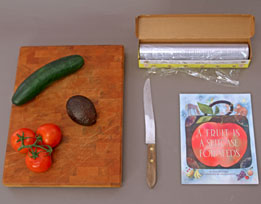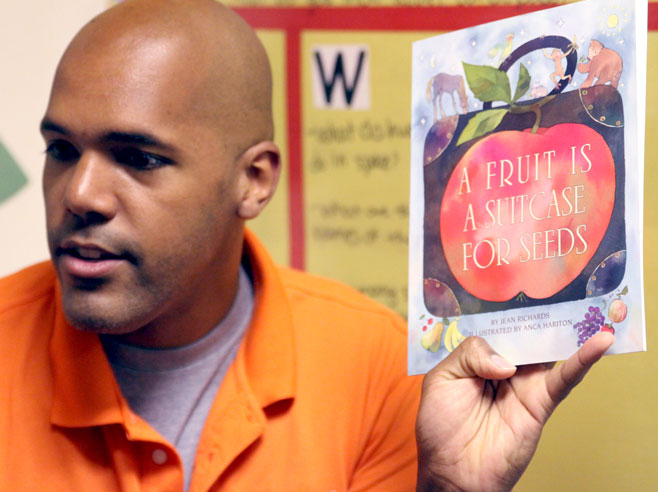Children listen to and discuss the book A Fruit Is a Suitcase for Seeds, by Jean Richards. They examine a selection of fresh fruits and the seeds inside.
Materials

- A Fruit Is a Suitcase for Seeds by Jean Richards
- Selection of fresh fruits and vegetables that vary in seed quantity, color, size, and distribution. Choose at least one fruit or vegetable from each of these categories: Fruits with many small seeds: kiwi, tomato; fruits with a few or many medium seeds: orange, cucumber, melon, pomegranate; fruits with a single large seed (pit): peach, nectarine, plum, avocado.
- Knife (for teacher use)
- Cutting board (for teacher use)
- Plastic wrap
Preparation
- Familiarize yourself with the pictures and text in A Fruit Is a Suitcase for Seeds.
- Gather the selection of fruits/vegetables suggested in the Materials list.
Directions: Lessons 9, 11, 12
Circle Time: Introduction
- Read A Fruit Is a Suitcase for Seeds, by Jean Richards. Take time to explore the illustrations with the class, encouraging children to name and discuss the fruits they see in the pictures. See what children think about some vegetables also being fruits! Explain that fruits have seeds that come from a flowering plant, and vegetables come from all other parts of the plant. Possible discussion ideas:
- Are potatoes and carrots fruits or vegetables? Lettuce and cabbage? Celery and broccoli? What part of the plant are they?
- Are apples and watermelons fruits or vegetables? What about cucumbers? How do you know?
- Show and discuss the fresh fruits and vegetables you have selected. These fruits and veggies will vary in seed quantity, color, size, and distribution.
- Show children one whole fruit/vegetable at a time. Have children share what they know about each fruit/vegetable and make observations. Possible discussion ideas:
- Who has eaten (a kiwi) before?
- What is the outside of the (kiwi) like? What color is it? How does it feel?
- What kind of seed do you think we will see when we cut it in half? How many seeds: just one, a few, many? What color seeds? Can you picture them? Let’s take a look!
- Cut the fruit in half to expose the seeds, or show precut fruits. Have children observe the actual fruit color and seed color. Possible discussion ideas:
- What part of the fruit do you plant to make new (kiwi) plants?
- How many seeds does this fruit have: one, a few, or many?
- How would you describe the seed size, seed shape, or seed texture?
- Where are the seeds located: in the center, spread throughout, or on the outside of the fruit?
- As you examine more fruits and vegetables, encourage children to observe, compare and contrast the seed size, texture, and location.
- Make the connection that a new fruit/vegetable plant can grow from each type of seed.
- What do you think would happen if you planted a (melon) seed? A (kiwi) seed?
- Can a (kiwi) grow from a (melon) seed? How do you know? Does anyone have a different idea?
- Do you need a large seed to grow a large plant, or can small seeds grow large plants?
- The fruit that was cut in half in this activity will be wrapped in plastic wrap and placed in the Learning Center for children to examine more closely and draw in the Drawing Fruits & Seeds activity.


